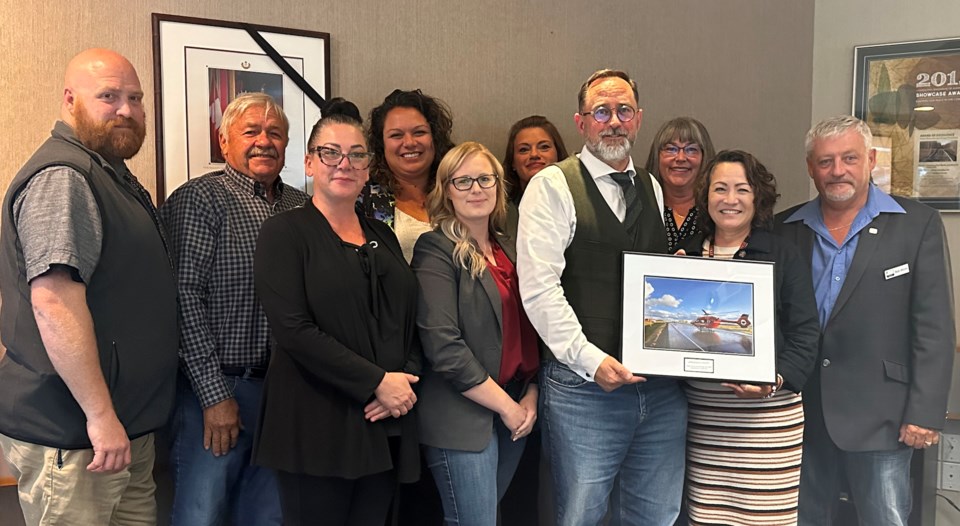ATHABASCA — With ongoing helipad projects in two communities within Athabasca County, a fuel cache installed at the regional airport last fall, and a recent mission to the Boyle Hell on Hooves event, locals have been seeing a lot of STARS in the last 12 months.
The organization made another stop in the area July 25, when STARS Senior Municipal Relations Liaison Glenda Farnden travelled to Athabasca to give her annual report to county councillors.
“It seems like it’s been extra special this year, because I’ve had the opportunity to bring you some further information about helipads in May, and now here I am again,” remarked Farnden.
Related: STARS put heliport-sized possibility in front of Athabasca
She shared two pieces of recent good news for the organization: in June, STARS and AHS signed a 10-year funding agreement that will guarantee the air ambulance service $15 million from the province each year.
“That’s really going to provide us a great sustainability piece moving forward,” said Farnden.
STARS will still have to make up almost $28 million per year through fundraising, by way of the STARS lottery, the calendar campaign, events, and contributions from both municipal and private corporation partnerships.
The other piece of positive news was the recent approval of a new life-saving measure, the Massive Hemorrhage Protocol. The protocol comes with two different products that can be administered to severe trauma patients in need of more than two units of blood, to fight anticoagulation and promote blood clotting.
“A brand new Canadian first — this was trailed in Saskatchewan last year, and it has only has just been approved last October in Alberta,” said Farnden. “We continue to try and stay on top of the game and advance the best in critical care.”
Municipal money
According to Farnden, 94 per cent of all rural municipal districts and counties in Alberta are partnered with STARS. Seventy five per cent of those partners contribute a minimum of $2 per capita, a level Athabasca County reached in late 2023 with a decision to increase their budget line to $14,000, up from the previous allocation of $10,000 per year.
News of the budget-time decision did not make its way to Farnden before her presentation.
Coun. Tracy Holland pointed out the county wasn’t shown on Farnden’s map with the gold border other municipalities contributing $2 per capita were bestowed, which proved to be a minor, yet nonetheless present, incentive for councillors.
Farnden thanked the group for their prior increase and said the ask for next year would be to create a standing line in the budget with $15,000 allocated every year going forward to further ensure funding stability for the air ambulance service.
“There’s council changes, and sometimes there’s significant fluctuation there, and our mission rate is not going down,” she said.
Councillors acted on her ask shortly after Farnden’s presentation; Coun. Rob Minns put a motion on the floor to increase the budget line for this year and in future years, sharing his take on why the move is an important one.
“We’re not talking about $1 million, or $3.6 million, or $5 million … I think it’s just a good thing to do, it’s a great service we get in Athabasca County,” said Minns. “It’s a just a good news story to forward this an extra thousand dollars — then we get that little box around our name, too.”
The motion passed with a vote of 8-1, with Coun. Gary Cromwell opposed.
As a thanks for the years of collaboration, Farnden presented council with a framed plaque accompanied by a photograph of a helicopter, as well as a handful of copies of the 2025 STARS calendar.
Local impact
Next year will mark STARS 40th year in Alberta, with more than 60,000 missions flown in the province in the last four decades.
An average of 23 missions per year are conducted within the boundaries of Athabasca County, adding up to 99 total missions since 2020. In the last four years, 34 critical inter-facility transfers have taken place at the Athabasca Healthcare Centre, and another 19 at the Boyle Hospital, although no transfers have taken place in the village in 2024.
Since 2010, 226 county residents have been flown by the air ambulance service; 183 of those residents were picked up within the borders of Athabasca County, but the remaining 43 residents were picked up in 22 different locations across Alberta and Manitoba — a statistic Farnden said stresses the importance of municipal support.
“Accidents and illness do not happen just because you’re close to home, and this is testament and proof of that,” said Farnden.
“Seeing the statistics is a little bit irrelevant to me,” said Coun. Joe Gerlach. “It’s the purpose that it serves, and it serves everybody, and we should participate on behalf our of citizens.”
To further critical care provision in rural and remote settings, STARS is working with AHS to implement a virtual care pilot project, which would allow STARS to assist hospital staff on the ground via iPads.
“We’re still working with Alberta Health Services and hoping to roll this out to more of the rural hospitals,” said Farnden. “If the helicopter might be out on another mission, it does not mean they do not have access to critical care, the rural physicians and nurses.”
She also passed on gratitude and thanks from the M.D. of Opportunity to councillors, noting the STARS fuel cache installed at the Athabasca Regional Airport in July 2023 has allowed the air ambulance to serve the residents of the remote district without fuel concerns.
Related: New fuel cache in Athabasca ‘opens up’ the north to STARS
“Every patient that’s transported by STARS also keeps a ground ambulance in service for someone else, and in rural areas … when those ambulances leave town, there’s not always another one sitting here waiting,” said Reeve Brian Hall. “To me, it’s especially important.”



